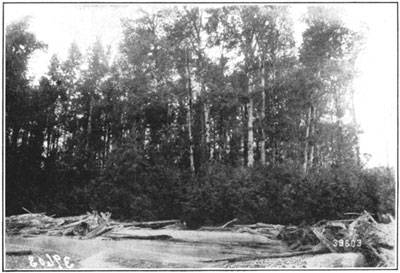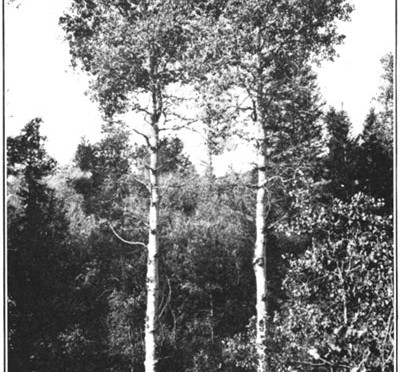Forests of Crater Lake National Park
Shrubs and Deciduous Trees
Beside the 12 to 15 cone-bearing trees that occur in the Crater Lake National Park, the beauty of its forests is further enhanced by several broadleaf species, and a wealth of shrubs and undergrowth round their feet.
Underneath the pines and firs on the lower slopes of the east side the dry pumice soil is covered with chinquapin and ceanothus, the former a wiry, compact shrub with pointed leaves, golden and powdery beneath, and prickly burs much like those of chestnut. The ceanothus, or buckbrush spreads out in large clumps and has shining, sticky, evergreen leaves that are pleasantly fragrant. Scattered through the forest are the slender crooked stems of the aspen (Populus tremuloides), with white bark and small heart-shaped leaves that never cease trembling in the breezes that sway the tops of the pines overhead. (fig. 23) In the stream bottoms and around springs are mingled willows, alders, and other shrubs, forming in the canyon of Anna Creek and elsewhere masses of light green in spring and summer. Over these the black cottonwood (Populus trichocarpa) lifts its massive trunks and wide-open heads, mingling among the darker green spires of the fir and spruces. (Figs. 24 and 25.)

Fig. 23—Aspen (Populus tremuloides).
Higher up in the park the shrubs are smaller, mostly huckleberry, manzanita, and dwarfed ceanothus, filling the openings and spreading beneath the lodgepole pine. Here the young forest growth is abundant — fine sharp-pointed little firs, lodgepole in dense thickets, and mountain hemlocks with their slender drooping tips and twigs.
In the region of heavy snows on the long outer slopes of Mount Mazama the hemlock, white pine, and firs form close, dark forests, beneath whose shade few shrubs can exists. Here a small dwarf huckleberry (Vaccinium microphyllum), currants, and one or two others form a broken carpet. The dry, open pumice slopes just below the edge of the crater support few shrubs among the scattered hemlocks and white-bark pines.
On the west side of the Cascade Divide the forests are more dense, with a greater wealth of undergrowth and shrubs. Willows, alders, and dogwoods fringe the streams and marshy meadows in great profusion. Here the Oregon yew (Taxus brevifolia) may be found, a small shrubby tree, related to the cedars and firs, with dark, glossy green needles, and in the late summer with sweet, coral-red berries. Its wood is dark red and almost as durable as the bowlers in the streams along which it grows. Over the drier ridges and points the huckleberry bushes are laden with dark purple fruit in early autumn. In this region, the Klamath Indians assemble and gather great quantities of the sweet berries for winter’s use.

Fig. 24—Black cottonwood (Populus trichocarpa).
The forests of Crater Lake National Park have an abundance of wild life, but there are no dangerous animals that need be feared during the summer season. Squirrels, spermophiles, rabbits, and porcupines are abundant in the timber and brush-covered areas, and deer, bears, and other large animals occasionally are seen. Numerous birds find an ideal home in its forests and along its streams, among them grouse of several kinds, grosbeaks, woodpeckers, and a few such as the Oregon jay and the Clarke nutcracker, common only in the higher mountain regions.
The traveler that makes only a fleeting trip to the park, sees the lake but once, and then passes on will overlook much of the best that the region can show. It is better to remain longer within the borders, to camp beneath its hemlocks and firs, to explore its peaks and forests, and look often and long upon its lake, whose blue waters and wonderful tree and cliff setting leave memories than can never be lost.
Other pages in this section
*** previous title *** --- *** next title ***


